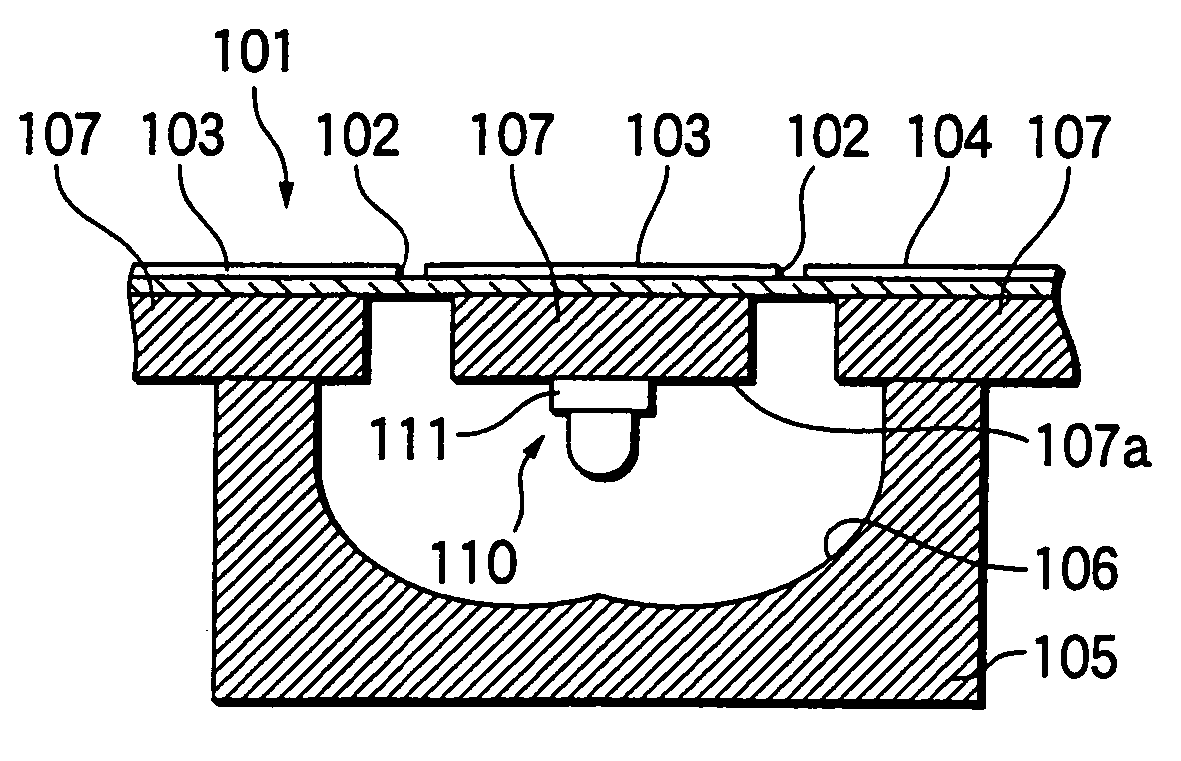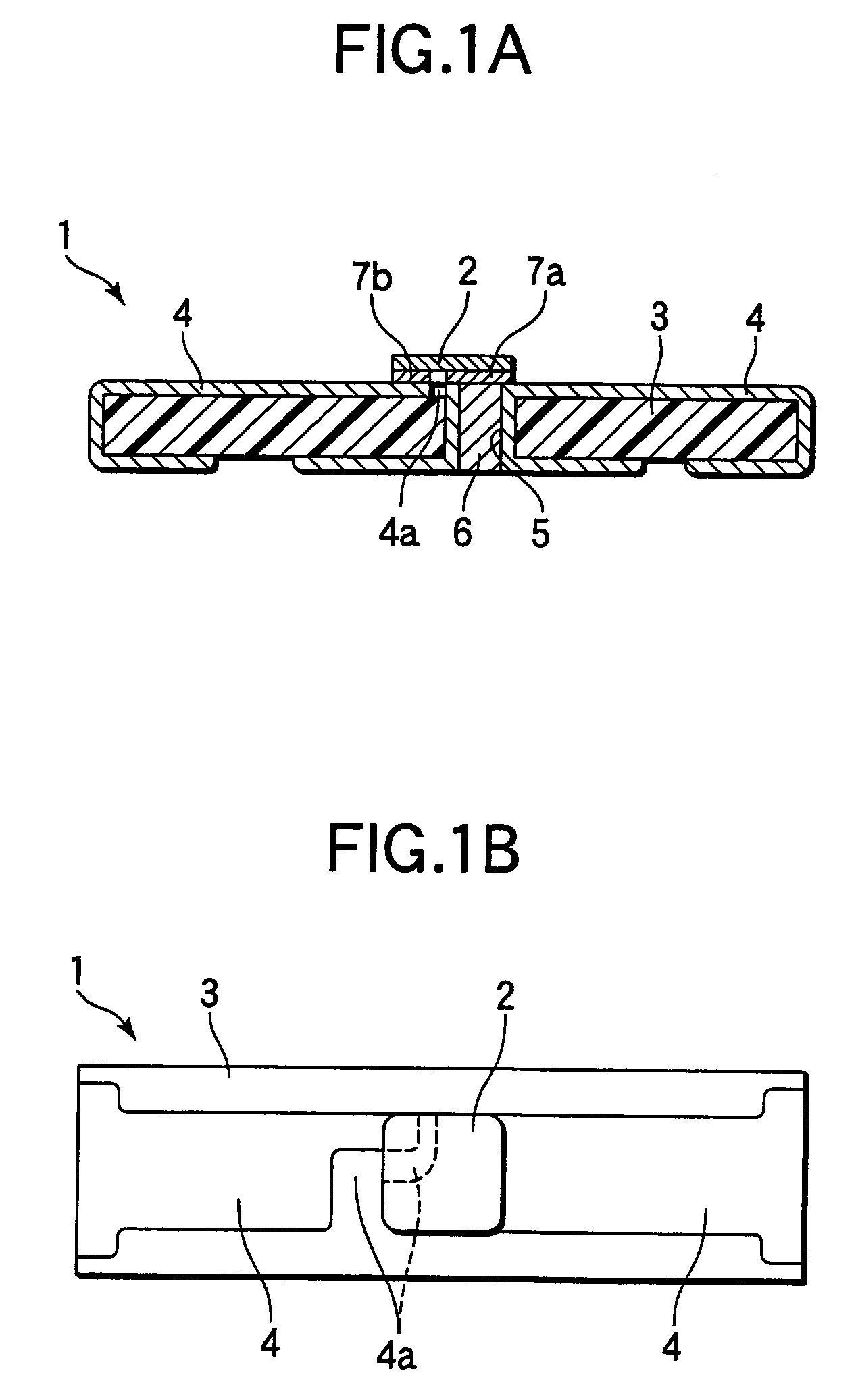Light emitting diode and manufacturing method thereof
a technology of light-emitting diodes and manufacturing methods, which is applied in the direction of semiconductor devices for light sources, light-emitting devices, fixed installations, etc., can solve the problems of reduced device life, reduced luminous efficiency, and heat dissipation, and achieve enhanced heat-emitting efficiency from the light-emitting portion
- Summary
- Abstract
- Description
- Claims
- Application Information
AI Technical Summary
Benefits of technology
Problems solved by technology
Method used
Image
Examples
first embodiment
[0078]First, a first embodiment of the invention is described with reference to FIGS. 1A and 1B. FIG. 1A is a longitudinally sectional view illustrating the entire configuration of a light emitting diode according to the first embodiment of the invention. FIG. 1B is a plan view thereof.
[0079]As illustrated in FIG. 1A, in an LED 1 of the first embodiment, a through hole 5 is drilled in a glass epoxy resin substrate. Moreover, a GaN light emitting element 2 is mounted on a through-hole substrate 3 having a conductive pattern 4 printed on the top and bottom surfaces thereof and on the inner surface of the through hole 5. The through hole 5 is filled with solder 6 acting as metal (heat radiation conductive member). One of the rear surface electrodes of the light emitting element 2 is electrically connected onto this through hole 5 by a gold bump 7a, while the other rear surface electrode is electrically connected to the side, which is insulated from the through hole 5, of the conductive...
second embodiment
[0084]Next, a second embodiment of the invention is described hereinafter with reference to FIGS. 2A and 2B. FIG. 2A is a longitudinally sectional view illustrating the entire configuration of a light emitting diode according to the second embodiment of the invention. FIG. 2B is a plan view thereof. Incidentally, like reference numerals designate like components of the first embodiment. Further, the description of such components is omitted herein.
[0085]As illustrated in FIGS. 2A and 2B, the LED 11 of this second embodiment differs from the LED 1 of the first embodiment in that in the former LED, the light emitting element 2 and a part of the through hole substrate 3 are sealed with transparent epoxy resin 8 serving as the light transmissive material, and that a light-emitting-surface-side part thereof is a convex lens 9 serving as a light radiating surface portion.
[0086]Thus, the quantity of light radiated from the light emitting element is increased by sealing the light emitting e...
third embodiment
[0088]Next, a third embodiment of the invention is described hereinbelow with reference to FIG. 3. FIG. 3 is a longitudinally sectional view illustrating the entire configuration of a light emitting diode according to the third embodiment of the invention.
[0089]As illustrated in FIG. 3, in an LED 21 of this third embodiment, an insulating film 24, on which copper foils 25a and 25b serving as two conductive foils are provided apart from each other, is stuck onto one 23a of a pair of leads 23a and 23b for supplying electric power to a GaN light emitting element 22. The thickness of the insulating film 24 is about 100 μm, while the thickness of the copper foils 25a and 25b is about 20 μm. Thus, the two rear surface electrodes are connected to the insulated two copper foils 25a and 25b by gold bumps 26a and 26b, respectively. Further, the surface of the copper foil 25a is electrically connected to one 23a of the leads by bonding using a wire 27a. Furthermore, the surface of the copper f...
PUM
 Login to View More
Login to View More Abstract
Description
Claims
Application Information
 Login to View More
Login to View More - R&D
- Intellectual Property
- Life Sciences
- Materials
- Tech Scout
- Unparalleled Data Quality
- Higher Quality Content
- 60% Fewer Hallucinations
Browse by: Latest US Patents, China's latest patents, Technical Efficacy Thesaurus, Application Domain, Technology Topic, Popular Technical Reports.
© 2025 PatSnap. All rights reserved.Legal|Privacy policy|Modern Slavery Act Transparency Statement|Sitemap|About US| Contact US: help@patsnap.com



